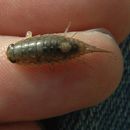Habitat
(
Inglês
)
fornecido por Invertebrates of the Salish Sea
Rock crevices or under stranded Macrocystis algae in the high intertidal during high tides; ranges through intertidal at evening, especially at low tide.
- licença
- cc-by-nc-sa
- direitos autorais
- Rosario Beach Marine Laboratory
Distribution
(
Inglês
)
fornecido por Invertebrates of the Salish Sea
Geographical Range: Sonoma County, CA to Central America.
- licença
- cc-by-nc-sa
- direitos autorais
- Rosario Beach Marine Laboratory
Habitat
(
Inglês
)
fornecido por Invertebrates of the Salish Sea
Depth Range: Intertidal
- licença
- cc-by-nc-sa
- direitos autorais
- Rosario Beach Marine Laboratory
Comprehensive Description
(
Inglês
)
fornecido por Invertebrates of the Salish Sea
This isopod is a member of suborder Oniscoidea. Flagellum of antenna 2 is much larger, with more than 10 articles when mature. Up to 2.5 cm long. Eyes separated by one full eye diameter. Uropods are nearly half as long as the body, with basal segments several times as long as broad.
- licença
- cc-by-nc-sa
- direitos autorais
- Rosario Beach Marine Laboratory
Look Alikes
(
Inglês
)
fornecido por Invertebrates of the Salish Sea
How to Distinguish from Similar Species: Does not get as large as Ligia pallasii, plus the very long uropods are nearly half as long as the body, while in L. pallassi they are much shorter.
- licença
- cc-by-nc-sa
- direitos autorais
- Rosario Beach Marine Laboratory
Comprehensive Description
(
Inglês
)
fornecido por Invertebrates of the Salish Sea
Biology/Natural History: Hides most of the day in crevices or under stones just above the high tide line. At night and at low tides in cool weather, forages throughout the intertidal zone. Is a scavenger, plus feeds on microscopic algae. This species is nearly terrestrial--it must keep its gills moist but will drown if forced to stay underwater. This species is very tolerant to water loss. They are paler at night than during the day due to clustering and dispersal of chromatophores. Animals on dark backgrounds remain darker than do those on light backgrounds. Ovigerous females have been observed at Monterey Bay in March, May, and June.
- licença
- cc-by-nc-sa
- direitos autorais
- Rosario Beach Marine Laboratory
Ligia occidentalis
(
Inglês
)
fornecido por wikipedia EN
Ligia occidentalis is a species of rock slater in the family Ligiidae. L. occidentalis is a habitat generalist of rocky shores. It is found in North America and Mexico. The western sea slater (sometimes called the rock louse) is separated from L. pallasi by its much longer uropods and its larger eyes, set closer together along with its sleeker body. This species has a tendency to bolt when disturbed. These sea slaters hide in rocky crevices above the high tide line during the day. It may emerge at night or in cooler weather to scavenge for algae and detritus along beaches or rocky cliffs. Western sea slaters must keep their gills moist in order to breathe but they cannot survive long underwater and will drown.[1][2][3]
References

- licença
- cc-by-sa-3.0
- direitos autorais
- Wikipedia authors and editors
Ligia occidentalis: Brief Summary
(
Inglês
)
fornecido por wikipedia EN
Ligia occidentalis is a species of rock slater in the family Ligiidae. L. occidentalis is a habitat generalist of rocky shores. It is found in North America and Mexico. The western sea slater (sometimes called the rock louse) is separated from L. pallasi by its much longer uropods and its larger eyes, set closer together along with its sleeker body. This species has a tendency to bolt when disturbed. These sea slaters hide in rocky crevices above the high tide line during the day. It may emerge at night or in cooler weather to scavenge for algae and detritus along beaches or rocky cliffs. Western sea slaters must keep their gills moist in order to breathe but they cannot survive long underwater and will drown.
- licença
- cc-by-sa-3.0
- direitos autorais
- Wikipedia authors and editors
Ligia occidentalis
(
Neerlandês; Flamengo
)
fornecido por wikipedia NL
Ligia occidentalis is een pissebed uit de familie Ligiidae. De wetenschappelijke naam van de soort is voor het eerst geldig gepubliceerd in 1853 door Dana.[1]
Bronnen, noten en/of referenties -
↑ Schotte, M. (2010). Ligia occidentalis Dana, 1853. In: Schotte, M., Boyko, C.B, Bruce, N.L., Poore, G.C.B., Taiti, S., Wilson, G.D.F. (Eds) (2010). World Marine, Freshwater and Terrestrial Isopod Crustaceans database. Gebaseerd op informatie uit het World Register of Marine Species, te vinden op http://www.marinespecies.org/aphia.php?p=taxdetails&id=257557
Geplaatst op:
15-12-2011
Dit artikel is een beginnetje over biologie. U wordt uitgenodigd om op bewerken te klikken om uw kennis aan dit artikel toe te voegen.

- licença
- cc-by-sa-3.0
- direitos autorais
- Wikipedia-auteurs en -editors
Ligia occidentalis
(
Vietnamita
)
fornecido por wikipedia VI
Ligia occidentalis là một loài chân đều trong họ Ligiidae. Loài này được Dana miêu tả khoa học năm 1853.[1]
Chú thích
-
^ Schotte, M. (2010). Ligia occidentalis Dana, 1853. In: Schotte, M., Boyko, C.B, Bruce, N.L., Poore, G.C.B., Taiti, S., Wilson, G.D.F. (Eds) (2010). World Marine, Freshwater and Terrestrial Isopod Crustaceans database. Gebaseerd op informatie uit het Cơ sở dữ liệu sinh vật biển, te vinden op http://www.marinespecies.org/aphia.php?p=taxdetails&id=257557
Tham khảo
- licença
- cc-by-sa-3.0
- direitos autorais
- Wikipedia tác giả và biên tập viên
Ligia occidentalis: Brief Summary
(
Vietnamita
)
fornecido por wikipedia VI
Ligia occidentalis là một loài chân đều trong họ Ligiidae. Loài này được Dana miêu tả khoa học năm 1853.
- licença
- cc-by-sa-3.0
- direitos autorais
- Wikipedia tác giả và biên tập viên

